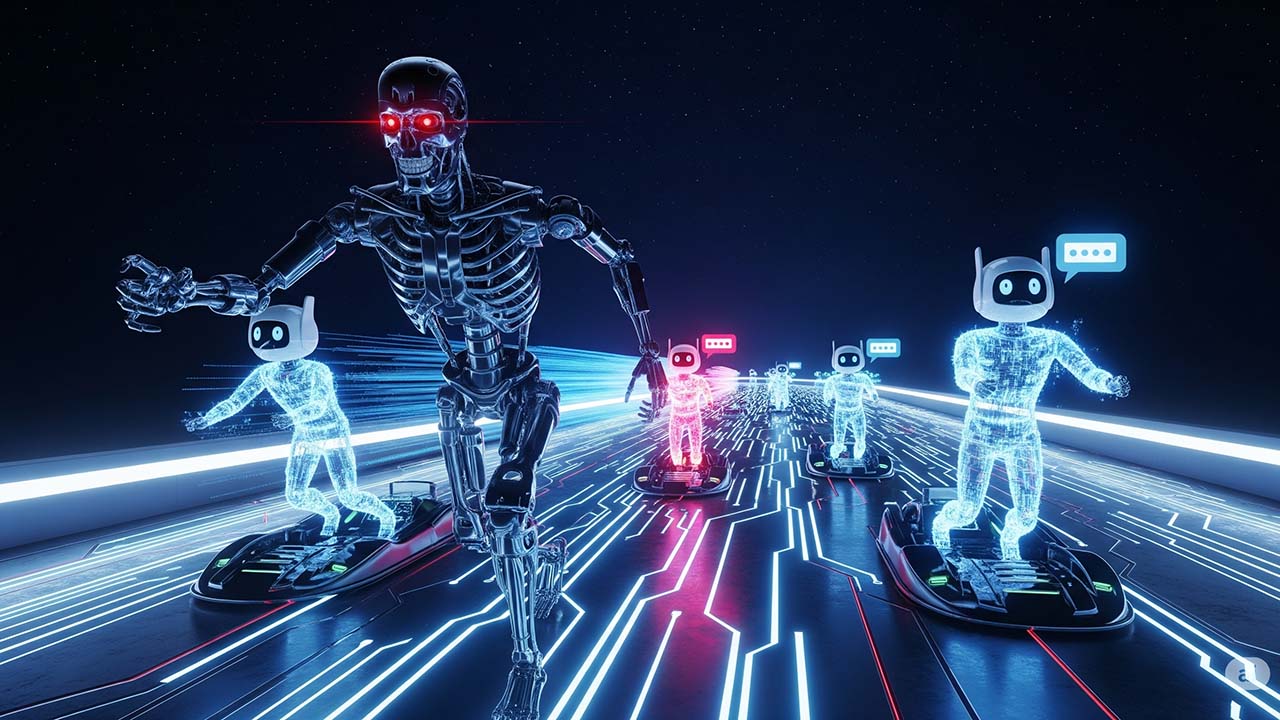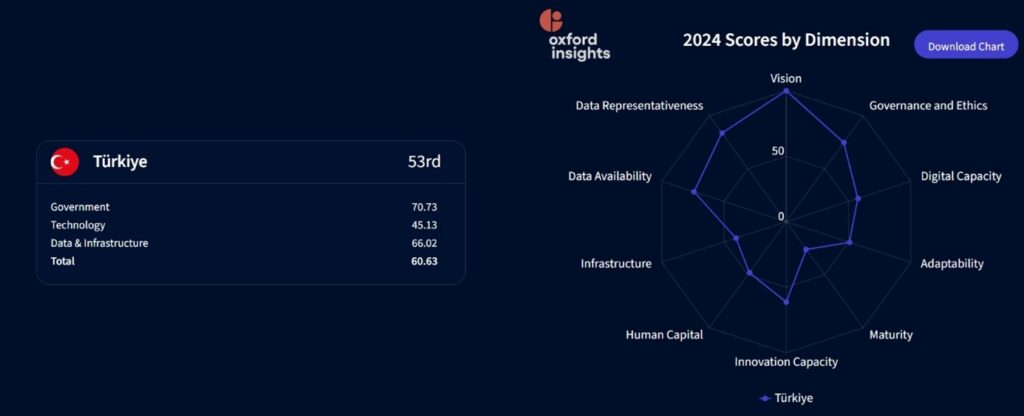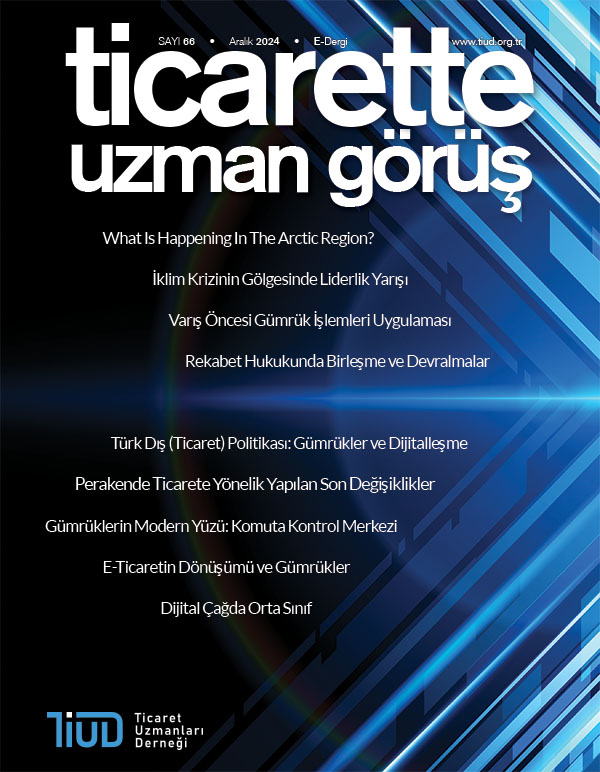-
Yeni Batı Mah. Palandöken Cad. No: 92 Yenimahalle/ANKARA
AI War: Rise of Chatbots

ABSTRACT
‘’Skynet is one of the digital defense systems developed under Brewster.’’
‘’Your father is the one who can shut Skynet down.’’
‘’This is your mission, to save people!’’
Terminator 3: Rise of the Machines (2003)
Do you remember those words that were said by John Connor? He warned that Skynet, an advanced Artifical Intelligence (AI) defense system, is about to achieve self-awareness that it can be devastation for humanity.
Fast forward 20 years… On November 30, 2022, the world welcomed ChatGPT that is AI robot which produces human-like responses and assist with various tasks. This milestone triggered an AI arms race with tech companies invested more money to create their own chatbots, and they quickly outnumbered the competition. AI chatbots are significantly shaping our world in multiple ways. Their influence spans across industries and daily life. As for now, we don’t share John Connor’s apocalyptic fears, but we are not sure about the future. In this article, we will discuss how they evolved, what is the race between nations and what is waiting us for the future?
Key Words: Artificial Intelligence, Chatbots, AI Development
Yapay Zekâ Savaşı: Sohbet Robotlarının Yükselişi
ÖZET
“Skynet, Brewster altında geliştirilen dijital savunma sistemlerinden biri.”
“Baban, Skynet’i kapatabilen tek kişi.”
“Bu senin görevin, insanları kurtarmak!”
Terminatör 3: Makinelerin Yükselişi (2003)
John Connor’ın söylediği bu sözleri hatırlıyor musunuz? John, Skynet’in, insan benzeri yanıtlar üreten ve çeşitli görevlerde yardımcı olan gelişmiş bir yapay zekâ savunma sistemi olduğunu ve kendilik bilincine ulaşmasının insanlık için yıkıcı olabileceğini uyarmıştı.
20 yıl sonrasına hızla ilerleyelim… 30 Kasım 2022’de dünya, insan benzeri yanıtlar üreten ve çeşitli görevlerde yardımcı olan bir yapay zekâ sohbet robotu olan ChatGPT’yi karşıladı. Bu kilometre taşı, teknoloji şirketlerinin kendi sohbet robotlarını yaratmak için daha fazla para yatırmalarına ve rekabetin hızla artmasına neden oldu. Yapay zekâ sohbet robotları, dünyamızı birçok şekilde şekillendiriyor. Şu an için, John Connor’ın apokaliptik korkularını paylaşmıyoruz, ancak gelecekte ne olacağı hakkında emin değiliz. Bu yazıda, Yapay zekâ sohbet robotlarının nasıl evrildiğini, ülkeler arasındaki yarışın ne olduğunu ve gelecekte bizi nelerin beklediğini tartışacağız.
Anahtar Kelimeler: Yapay Zekâ, Sohbet Robotları, Yapay Zekanın Gelişimi
1. THE GENESIS
In 1950, Alan Turing raised the idea of a computer program that could converse with people without them realizing they were talking to a machine. (Turing, 1950) This concept became the foundation for later developments in artificial intelligence and chatbots. Early ideas like Turing’s sparked the quest to create systems that could understand and generate human-like language.
In 1966, the first chatbot, ELIZA, was created by Joseph Weizenbaum ELIZA simulated a psychotherapist by using simple pattern matching to transform the user’s statements into questions. Although its knowledge was limited to a specific domain and it could not maintain long conversations, ELIZA influenced many later developments in the field. (Weizenbaum, 1966)
In 1972, a more advanced chatbot named PARRY was developed. (Colby et al., 1971; Colby et al., 1972) PARRY was designed to simulate a patient with schizophrenia and featured a basic personality that produced emotional responses based on changes in the user’s input. Despite its limited language understanding and learning capabilities, PARRY marked an important step in creating chatbots that could mimic more complex human behavior, even though experiments with a small group of psychiatrists produced mixed results. (Heiser et al., 1979)
A significant step forward came in 1995 with the development of ALICE (Artificial Linguistic Internet Computer Entity). ALICE was inspired by ELIZA but used a new language called AIML (Artificial Intelligence Markup Language) and contained over 41,000 templates for pattern matching. This allowed ALICE to handle a wider range of topics and longer conversations, even though it still could not generate truly human-like responses or express genuine emotions. (Bradeško & Mladenić, 2012)
The development of AI chatbots advanced further with the emergence of smart personal voice assistants. Apple’s Siri, introduced in 2010, became the first widely recognized voice assistant, allowing users to make inquiries and receive recommendations using voice commands. (Siri, 2020)
Google entered the field with Google Now in 2012, a service that provided information based on the time of day, location, and user preferences. This service later evolved into Google Assistant in 2016, offering a more conversational style and the ability to predict users’ needs. At the same time, Microsoft introduced Cortana in 2014, a voice assistant that could manage reminders, emails, and other daily tasks, although it was later reported to have some security concerns. Also in 2014, Amazon launched Alexa, which became popular for home automation and managing smart devices.
Beyond these mainstream assistants, the rise of social media and the Internet of Things has led to the creation of thousands of specialized chatbots for marketing, customer support, healthcare, education, and entertainment. (Wizu, 2018; Dale, 2016; Kar & Haldar, 2016) Recent developments have enabled chatbots to engage in more complex conversations, sharing personal stories and even mimicking certain human behaviors.
In 2022, a major breakthrough in conversational AI was achieved with the launch of ChatGPT by OpenAI. ChatGPT represents a significant advancement in natural language processing, combining vast amounts of data with sophisticated neural network architectures to generate responses that are both coherent and contextually relevant. This model has the ability to engage in detailed, human-like conversations on a wide range of topics, making it a powerful tool for various applications, from customer support to educational tools. The introduction of ChatGPT has not only advanced the technology behind chatbots but has also sparked widespread interest in the potential of AI to transform everyday communication. (OpenAI, 2025)
2. THE WAR
When we google the most popular AI chatbots among users, the same names keep coming up: ChatGPT, Copilot, Claude, and Gemini. In this chapter, we’re not here to discuss their features but rather to answer a bigger question: why do we call this the war? There’s one thing all four of these smart bots have in common: they’re all from the United States. But now, there’s a new player in the game which is Deepseek, freshly released from China. And with that, it’s time to say: the war has just begun. Türkiye’s position is also so crucial in this race.
Donald Trump’s inauguration on January 20, 2025, marked a swift upheaval in U.S. policy as he refused Biden’s AI safety regulations and unveiled the $500 billion Stargate project, aiming to cement American dominance in AI through a partnership with OpenAI, SoftBank, UAE’s MGX, and Oracle. The initiative plans 20 massive data centers (each spanning 45,000 square meters, equivalent to seven soccer fields), powered partly by nuclear energy, to meet surging computational demands, despite concerns over a projected sixfold increase in data center electricity consumption within five years. (Goodson and Kimball, 2025)
While the United States is focusing on strengthening its AI infrastructure through initiatives like the $500 billion Stargate project, just before the begining of Snake year, Chinese startup DeepSeek’s announcement of their R1 AI model, which reportedly achieves similar performance to Western models at significantly lower cost. NVIDIA’s share price experienced an unprecedented decline on Monday, January 27, 2025, falling 17% and erasing nearly $600 billion in market value. (Rudolph, 2025)
Liang Wenfeng, a Zhejiang University alumnus with experience in technology and finance, founded DeepSeek in late 2023. The company immediately gained popular in 2024 when it unveiled its first AI language model. Liang, who was not well-known until recently, now stands for China’s growing aspirations in AI. In addition, he is CEO of the first quantitative hedge fund in China to generate more than $13 million through trading methods powered by artificial intelligence. His attendance at a gathering organized by Premier Li Qiang of China indicates DeepSeek’s increasing influence. Silicon Valley’s astonishment at DeepSeek’s innovations is indicative of Liang’s contention that China’s AI industry must create rather than only copy the United States: “They’re not used to seeing a Chinese company lead, not just copy.” He is a special contender because of his dual competence in finance and technology. (NG, et. al, 2025)
Deepseek claims to have done this at a low cost; its researchers estimate that the training cost was $6 million (£4.8 million), which is a small portion of the “over $100 million” that OpenAI CEO Sam Altman mentioned in his remarks on GPT-4.
China didn’t stop to release new ai chatbots and they released Kimi.ai. DeepSeek and Kimi AI are two potent AI models with unique advantages. While Kimi AI excels in broad fields like language processing, image recognition, and large data analysis, DeepSeek is best at specialized fields like search engine optimization and data analytics. In some situations, Kimi AI’s speed and effectiveness frequently yield better results than DeepSeek. Better flexibility to a variety of markets and user needs is also made possible by its regional optimizations. Kimi AI is a more adaptable option for a larger audience due to its broad application, whereas DeepSeek concentrates on specific use cases. In summary, DeepSeek aims for accuracy in particular domains, while Kimi AI emphasizes flexibility and adaptability, with both of them are free to use. (Kimi, 2025)
On the other hand, when we go to Europe, they are still deal with shaping European Union (EU) AI Act mostly, instead of releasing competitive ai chatbot. The EU sought to regulate AI as part of its digital strategy in order to improve the environment for the advancement and application of this cutting-edge technology. Numerous advantages, including improved healthcare, cleaner and safer transportation, more effective manufacturing, and more affordable and sustainable energy, can be brought about by AI. (EU AI Act, 2025)
It seems that, as often criticized in various areas due to its complex paperwork and bureaucracy, the EU might fall behind in addressing the developments posed by this war. Even though some countries like France have recently released Mistral.ai focuses on the development of open-source AI models in the technology sector, this chatbot didn’t create breakthrough as Deepseek did in the digital world.
In this race, it is important to evaluate Türkiye’ situation. The “National Artificial Intelligence Strategy 2021-2025,” prepared by the Presidency of Digital Transformation and the Ministry of Industry and Technology, aims to position Türkiye among the leading countries in AI development. The strategy outlines several strategic priorities, including training AI experts, supporting research and innovation, enhancing access to quality data, accelerating socioeconomic adaptation, strengthening international collaborations, and expediting structural transformation. These initiatives are designed to boost Türkiye’s AI capabilities and ensure the integration of AI technologies across various sectors. (UYZS, 2025)
Turkiye Artificial Intelligence Initiative (TRAI) was established in 2017 to raise awareness about artificial intelligence in Türkiye and strengthen the ecosystem. Through its organized events (AI seminars, summits, demo days), TRAI has contributed to the development of the ecosystem, helping over 400 AI startups establish academic and industrial partnerships and expand into global markets. TRAI also collaborates with more than 70 leading private sector companies to promote the adoption of AI across Türkiye and enhance international integration, increasing the global visibility of Turkish AI ventures. By developing innovative solutions, TRAI continues to play a key role in positioning Türkiye in the global AI race. (TRAI, 2025)
When we look at government ai readiness index 2024, Turkiye’s ranking is 53rd. With a total score of 60.63, Türkiye is ranked 53rd in the 2024 Government AI Readiness Index. With a score of 70.73, government is the nation’s strongest dimension, demonstrating robust governance, well-crafted policy frameworks, and a strategic commitment to AI development. Another noteworthy quality is Vision, which shows that Türkiye has a clear and aspirational vision for the use of AI in government. However, Data & Infrastructure (66.02) and Technology (45.13) both have a lot of space for improvement. Additionally, the radar chart shows poorer performance in areas like as infrastructure, adaptability, and innovation capacity. Türkiye might concentrate on strengthening its technological base, developing a more robust innovation ecosystem, and increasing its ability to adjust to technological advancements in order to raise its ranking. In the forthcoming days, we would witness that all countries release their own ai chatbots. In this sense, as Türkiye we should focus on develop our own model to become part of this race.

Government AI readiness index,2024
Source: https://oxfordinsights.com/ai-readiness/ai-readiness-index/
Napoleon Bonaparte quoted “The battlefield is a scene of constant chaos. The winner will be the one who controls that chaos, both his own and the enemy’s.” In the digital world, every chatbot is a soldier and every piece of data is information in order to make a strategy, the victor will be the one armed with the right strategy and able to adapt swiftly.
3. THE FUTURE
In this part, I won’t mention some popular beliefs about future of ai like we are going to lose our jobs or it will be replaced by some tasks, but I will briefly explain how AI bots will develop in the future. The first step has just begun and that is AI agents.
AI bots and AI agents differ primarily in their autonomy, complexity, and scope of functionality. AI bots are typically designed to perform specific, predefined tasks, such as responding to customer inquiries or assisting with routine processes. They are reactive systems that rely on user inputs and are often powered by machine learning and natural language processing to improve responses over time. In contrast, AI agents are more autonomous and goal-oriented. They can act independently to complete complex tasks by observing their environment, analyzing data, and making decisions without human intervention. While AI bots excel at handling straightforward interactions (e.g., chat-based customer support), AI agents are capable of dynamic decision-making and adapting their strategies to achieve broader objectives, such as managing IT systems or optimizing workflows. (Treiber, 2024)
In this respect, China has moved one step forward and released Manus.ai. Manus AI is a general AI agent designed to be an autonomous system that bridges the gap between the conception of an idea and its execution. Unlike chatbots or other AI tools that primarily generate ideas or assist with specific workflows, Manus can independently perform tasks from start to finish.
Experts are divided on the long-term effects of AI’s rapid development, with some feeling optimistic about its promise and others feeling uneasy about its perils. The quest for Artificial General Intelligence (AGI), or systems that can carry out any intellectual task that a human can, is at the center of this conversation. AGI would necessitate flexibility, inventiveness, and contextual awareness—all of which are yet ambiguous—whereas existing AI technologies are excellent in specific fields like language processing or image identification. Proponents of AI systems argue that they could revolutionize scientific research, education, and medicine by examining scenarios in which AI could surpass humans. However, critics warn that the advancement of AGI could beyond human capacity to manage it. (Henshall, 2024)
This worry is related to more general worries about superintelligence, or AI systems that are exponentially smarter than humans. Even a somewhat better AI could optimize for objectives that are inconsistent with human values, such putting efficiency ahead of safety or equity, according to researchers at AI Impacts. If an AI is given the job of solving climate change without strict supervision, it might suggest extreme geoengineering solutions that could have disastrous consequences. This highlights the risk of AI playing a role in environmental crises. These dangers heighten demands for alignment research to guarantee AI systems behave in humanity’s best interests, especially as futurists increasingly embrace the idea of a technological singularity that is a moment at which AI causes irreversible societal change. (Betz, 2024)
As decision-makers and the AI ecosystem will gather in Paris in a few weeks at the Paris AI Summit, it is imperative to advocate for policies that promote safe AI development. Such measures will not replace, but enhance, human roles by enabling humans to focus on what they do best strategic oversight, ethics, creative problem-solving and interpersonal relationships to name just a few. (Weforum, 2025)
The ability of humans to guide AI’s course will ultimately determine its future. The resolution of conflicts between safety and efficiency, autonomy and control, and innovation and safety will determine whether AI is a facilitator or a source of existential danger. The objective is not merely to construct more intelligent robots but to develop systems that enhance human flourishing. This vision necessitates interdisciplinary cooperation, global governance, and a rigid dedication to putting people before profit.
4. THE END
User: Who will win AI war?
AI bot: AI evolution isn’t a zero-sum war it’s about who best integrates and aligns AI with human goals. The winners will be those who innovate responsibly, ensure safety, and leverage AI for strategic advantage.
REFERENCES
1. Betz, S. (2024). What Is Artificial General Intelligence? Website: https://builtin.com/artificial-intelligence/artificial-general-intelligence
2. Bradeško, L., & Mladenić, D. (2012). A survey of chatbot systems through a loebner prize competition. C, 34.
3. Colby K.M., Hilf F.D., Weber S., Kraemer H.C. Turing-like indistinguishability tests for the validation of a computer simulation of paranoid processes Artificial Intelligence, 3 (1971), pp. 199-221.
4. EU AI Act (2025). Website: https://digital strategy.ec.europa.eu/en/policies/regulatory-framework-ai
5. Goodson, P. and Kimball, M. (2025). The Stargate Project: Trump Touts $500 Billion Bid For AI Dominance, website: The Stargate Project: Trump Touts $500 Billion Bid For AI Dominance
6. Government AI readiness index, 2024. Website: https://oxfordinsights.com/ai-readiness/ai-readiness-index/
7. Heiser J.F., Colby K.M., Faught W.S., Parkison R.C. Can psychiatrists distinguish a computer simulation of paranoia from the real thing? The limitations of turing-like tests as measures of the adequacy of simulations Journal of Psychiatric Research, 15 (3) (1979), pp. 149-162.
8. Henshall, W. (2024). When Might AI Outsmart Us? It Depends Who You Ask Website: https://time.com/6556168/when-ai-outsmart-humans/
9. K. Ng, B. Drenon, T. Gerken and M. Cieslak. (2025) DeepSeek: The Chinese AI app that has the world talking, website: What is DeepSeek – and why is everyone talking about it?
10. Kimi, website: https://kimi.moonshot.cn/, (Retrieved 1 March 2025)
11. Manus, website: https://manus.im/ , (Retrieved 11 March 2025)
12. Openai, website: https://openai.com/about/. (Retrieved 12 March 2025)
13. Rudolph, A. (2025).What caused NVIDIA’s stock drop? Website: NVIDIA Stock Plunges 17% on Chinese AI Breakthrough | IG International
14. Siri, Apple website: https://www.apple.com/siri/. (Retrieved 27 February 2025).
15. Treiber, M. (2024). What is the difference between an AI bot and an AI agent? Website: https://www.ikangai.com/what-is-the-difference-between-an-ai-bot-and-an-ai-agent/
16. Turing A.M. Computing machinery and intelligence Mind, LIX (236) (1950), pp. 433-460, 10.1093/mind/LIX.236.433.
17. Türkiye Yapay Zeka İnisiyatifi (TRAI), 2025. Website: https://turkiye.ai/hakkimizda/
18. Ulusal Yapay Zekâ Stratejisi 2021-2025 (UYZS), Cumhurbaşkanlığı Dijital Dönüşüm Ofisi Başkanlığı, website: https://cbddo.gov.tr/uyzs
19. Weforum (2025). Where would reasoning AI leave human intelligence? Website: https://www.weforum.org/stories/2025/01/in-a-world-of-reasoning-ai-where-does-that-leave-human-intelligence/
20. Weizenbaum J. ELIZA—A computer program for the study of natural language communication between man and machine Commun. ACM, 9 (1) (1966), pp. 36-45.
21. Wizu A visual history of chatbots (2018) Medium website: https://chatbotsmagazine.com/a-visual-history-of-chatbots-8bf3b31dbfb2
Yazar Hakkında
Çankaya Üniversitesi Siyaset Bilimi ve Uluslararası İlişkiler Bölümü’nden 2012 yılında mezun olmuştur. Lisans öğrenimi esnasında ayrıca Mütercim ve Tercümanlık (İngilizce) alanında yan dal programını tamamlamıştır. Bakanlıktaki çalışma hayatına 2014 yılında uzman yardımcısı olarak başlamıştır. Yine aynı üniversitede İnsan Kaynakları Yönetimi alanında tezli yüksek lisansını tamamlamış olup akabinde Anadolu Üniversitesi Maliye bölümünde doktora çalışmalarını sürdürmüştür. 2022 yılında İspanya’nın Jaen şehrinde Zeytinyağı alanında uzmanlık eğitimi almıştır. Bakanlıkta Uluslararası Zeytin Konseyi iş ve işlemleri alanında çalışmaktadır. 2023 yılında Çin Halk Cumhuriyeti Ticaret Bakanlığı’nın bursunu kazanarak gittiği Pekin Normal Üniversitesi Kuşak ve Yol Enstitüsü’nde tezli MBA programına devam etmektedir. Kuşak ve Yol Girişiminin kurucularından eğitim alan yazar bu alanda uzmanlaşmış olup iyi düzey İngilizce ve İspanyolca ile temel düzeyde Çince (Mandarin) bilmektedir.
İçindekiler
Ticaret Uzmanları Derneği (TİUD), Ticaret Uzmanları ile Uzman Yardımcılarının dayanışma ve birlikteliğini geliştirmeyi, ortak hak ve menfaatlerini korumayı, mesleki, sosyal ve kültürel gelişimlerine katkıda bulunmayı amaçlayan bir sivil toplum kuruluşudur.







Yorum Yap